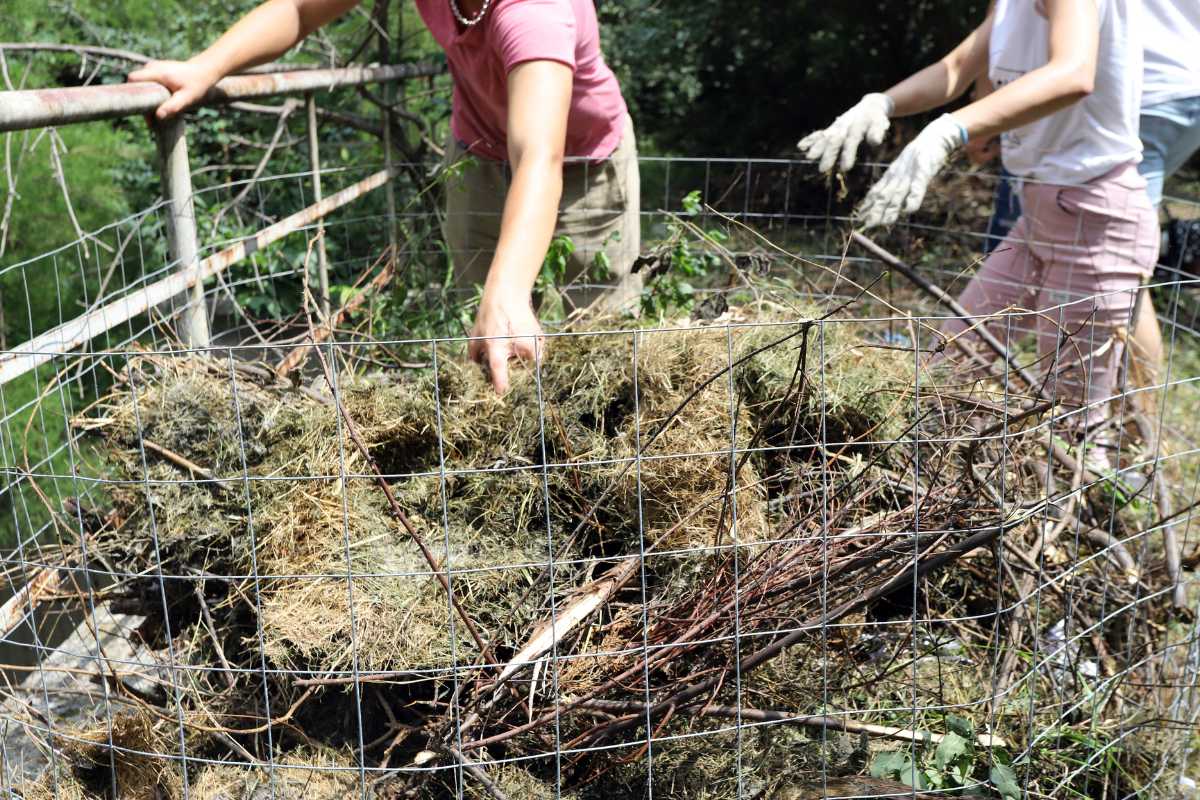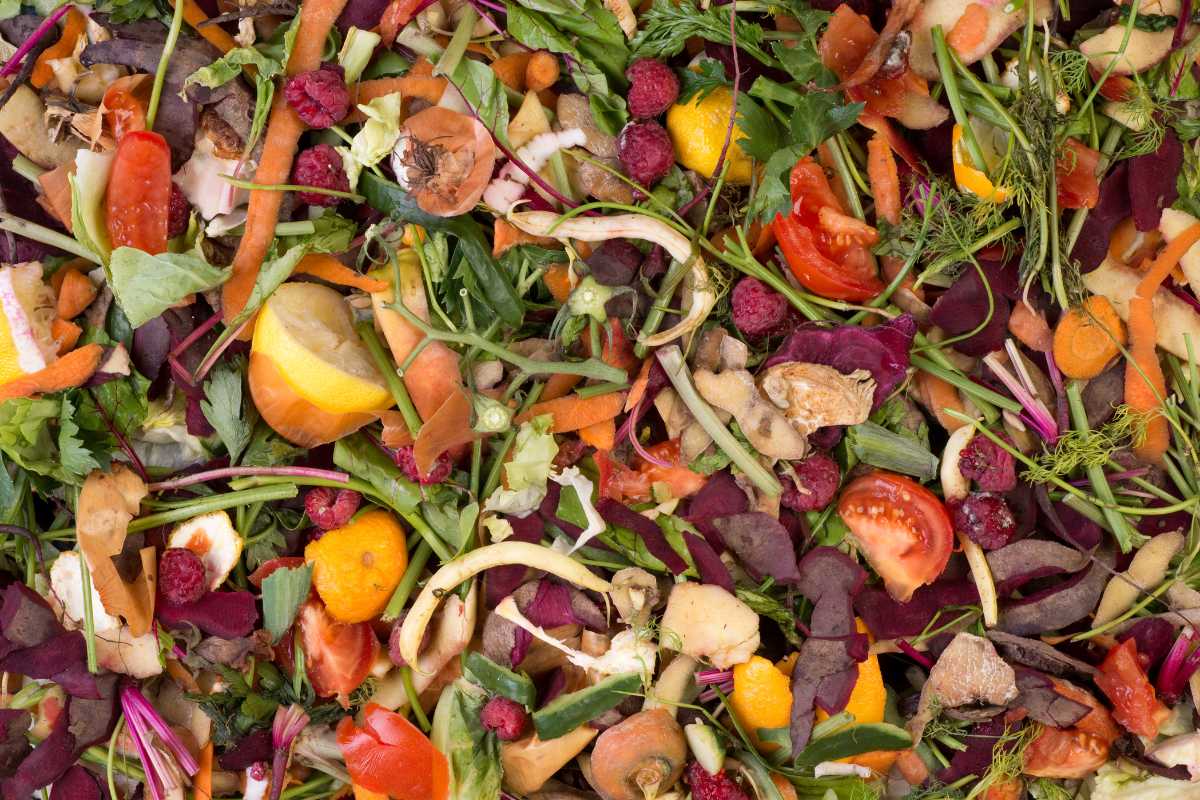Compost heaps are more than just piles of rotting matter. To make decent compost, you need to monitor what you add to your composter, and how much of it you mix in.
When discussing how to start composting, you will often hear gardeners refer to ‘greens’ and ‘browns.’ These are the categories that organic materials fall into depending on their chemical content and composition.
I’m going to detail what they are and why getting the compost green brown ratio right is so important for your garden.
In this article, I’m going to discuss the importance of getting a good mix of compost ingredients that will break down to make nutrient-rich compost for your garden.
- Related article: What Can You Compost?
What are Brown Materials for Composting?

Brown materials are generally ones that are dry and slow to break down.
Brown materials include: Dry leaves, hay, straw, wood, cardboard, unbleached paper, sawdust, pine needles, and dry plant cuttings.
Browns are rich in carbon, which is an important soil additive. Carbon promotes healthy growth in plants as they convert it to energy.
Carbon is the main component of soil organic matter. It helps maintain the soil’s fertility, structure, and capacity for water retention.
Browns help your compost by adding space for airflow, and slowing down the microbial breakdown which prevents excess heat.
What are Green Materials for Composting?

Green materials are usually wet and break down quickly.
Greens are rich in nitrogen, which is a major component of chlorophyll. Plants need chlorophyll in order to convert sunlight into energy. Nitrogen also makes up the building blocks of proteins, which plants use for energy.
Green matter includes: Fruit and vegetable scraps, fresh grass clippings, fresh weeds, coffee grounds, tea leaves, fresh plant cuttings, animal manure, pond sludge, feathers, hair, and dead fish or birds.
Dead fish and birds should only be added to your compost occasionally, as they may attract pests.
While eggshells are usually grouped with greens, they are technically not considered to be brown or green. That’s because they are rich in calcium rather than carbon or nitrogen.
The Best Browns to Greens Ratio

The best ratio of greens and browns is 50/50. If you keep your mix of browns to greens to 50/50 then your compost will do just fine.
You may find information on the internet that talks about a Carbon to Nitrogen ratio (C:N ratio) of 30 parts carbon to 1 part nitrogen.
However, the carbon-nitrogen ratio is not the same as the green to brown ratio. Greens don’t only contain nitrogen and browns aren’t solely made up of carbon.
Green and brown materials usually have their own C:N ratio. Greens have a low ratio of carbon to nitrogen. Browns have a high C:N ratio of 30:1 or more.
Why is a Good Brown-Green Ratio Important?
Getting this mix right is essential for the health of your compost pile. Too much of one or the other is the cause of most problems with your compost.
Too much green: Too much green materials on your compost can mean you are left with a slimy, smelly mess rather than usable compost.
As green materials break down quickly, they are the cause of a lot of excess heat. If your compost is too hot, it may be that you have too much green material in your compost.
Too much brown: Too much brown ingredients will usually result in your compost not breaking down at all.
It is also important that you mix up the greens and browns thoroughly through turning. Add a layer of brown compost for every layer of green, and you can also turn it over with a garden fork occasionally.
You don’t want pockets of dry material next to pockets of wet material, as the green material will generate heat when decomposing. That heat in extreme circumstances can cause the dry brown material to catch fire.
Compost Troubleshooting Browns and Greens
If you notice any signs of trouble, such as an increase in odor, flies around the area, or if there is no progress after several weeks, take action immediately!
There are many reasons why your compost might smell bad. The first thing to check is whether you have enough air circulation.
Here are some common compost issues you might run into and how to troubleshoot them. You can often add materials to fix them.
- Compost smells bad – This is likely because there is too much green material, and air cannot get into the compost. Add some browns and give it a good mix with a garden fork. You could also try adding some pebbles to help aerate the compost pile.
- Compost not breaking down – Too much brown material will mean that the compost will just sit there. Moisture and heat are needed to aid decomposition, as well as attract worms and other bugs.
- Compost is too wet – Usually means the compost pile has too much green. Dig in sawdust, wood-chips, cardboard or hay to stop your compost becoming too sludgy.
- Compost is too cold – Add some greens to start the microbial breakdown which will warm up your compost.
- Compost is too hot – Add browns to slow down the breakdown process that’s causing the excess heat.
- Compost is too dry – Means that there’s too many browns in the compost. Green compost adds much needed moisture to the pile. Add food scraps, vegetable and fruit scraps, teabags and coffee grinds to compost that is too dry.
Most of the issues with compost stem from an imbalance of green and brown materials. By ensuring you have a fifty-fifty mix of greens and browns, you will avoid most common composting issues.
An inconsistent mix will also have an effect on your plants when it comes to using your compost in your garden. If there is too much nitrogen in the compost, it will pass into the soil.
Excess nitrogen in the soil will mean that, while your plants look healthy, they will struggle to produce flowers or fruit.
Compost can usually be saved, no matter the issue, but it is important to have patience and help your compost along by using the right mix of ingredients. All you need to do is get the mix right, and the composter will do all the work for you with little to no maintenance required!
Compost Browns and Greens Final Thoughts
A balanced diet is essential to maintain a healthy body, and a compost heap is no different. Maintaining a balance in the types of materials you add to your compost heap will ensure your compost is healthy. That will benefit your plants by passing on essential nutrients.
The balance of greens and browns will also keep your compost from smelling, and speed up the breakdown of brown material.
Remember, it’s all about the end result with compost. Your aim is to get earthy, crumbly compost that doesn’t smell and can be dug into your garden or used as a mulch.
Learn more about Composting:
Browns and Greens FAQs
What is the correct ratio for composting?
The correct ratio for composting is 50% browns and 50% greens. The more variety of browns and greens you use, the better quality compost you’ll make.
Can I mix green and brown compost?
Yes, you should mix green and brown compost together. An inconsistent mixture of ingredients will affect the growth of your plants. That will lead to issues with your compost like foul odors, compost getting too hot or cold, too wet or dry, and even the materials not breaking down.
How much brown material do I need for compost?
You need the same amount of brown material for the compost as you have green material for a 50/50 ratio. So, if you have 1 kg of green waste then you would need 1 kg of brown material.
Are coffee grounds green or brown compost?
Coffee grounds are green compost material. They are high in nitrogen, which help plants convert light into energy.
Are coffee grounds good for compost?
Coffee grounds are good for compost because they contain lots of nitrogen. Nitrogen helps plants grow strong roots and leaves. It also makes them stronger against disease. Coffee grounds are one of the best sources of nitrogen available.
Are eggshells good for compost?
Eggshells are good for compost because they contain calcium carbonate, which helps break down organic matter. Egg shells are also rich in phosphorus, potassium, magnesium, iron, zinc and manganese. These elements are vital for plant health.
What are examples of brown material for composting?
Examples of brown materials that are good for compost include: Dry leaves, wood, cardboard, unbleached, paper, sawdust, pine needles, dry plant trimmings, straw, and hay.
What Happens if the C:N Ratio is Wrong?
If the Carbon-Nitrogen Ratio is wrong, issues such as bad smells, poor decomposition rates, and slow turnover times may occur. If this happens, try adding some extra carbon or less nitrogen. You could also increase the temperature slightly. Maintaining a 30:1 C:N Ratio is best.

